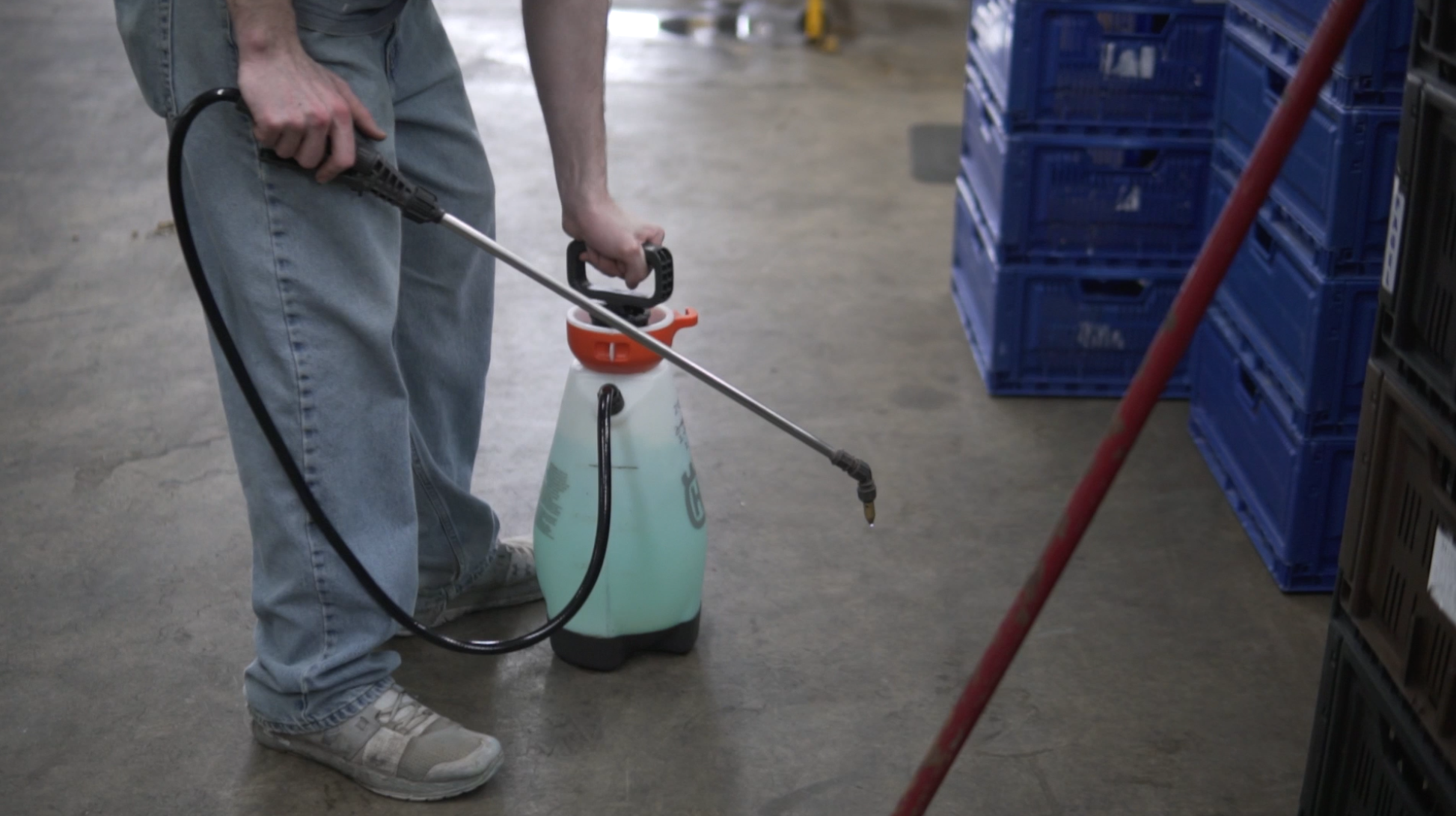Things to Consider When Spring Cleaning
Allissa Conley, Produce Safety Technician
![]()
Springtime is here and there are many things to do on the farm to prepare for the upcoming season. When it comes to produce safety, cleaning and sanitizing all equipment used during harvesting or packing should be a high priority on the to-do list. Equipment that does not get cleaned on a regular basis should also get some extra attention. This can include packing and picking containers, packing equipment, buildings, transport vehicles, utensils, and much more. We have compiled a list of resources below to help navigate the cleaning and sanitizing of different equipment and areas on the farm.

Cleaning and Sanitation Basics
- Document: “Cleaning vs. Sanitizing” by Produce Safety Alliance
- Video: “Cleaning, Sanitizing, & Disinfecting” by MSU Extension Produce Safety
- Document: “Introduction to Selecting an EPA-Labeled Sanitizer” by Produce Safety Alliance
When cleaning and sanitizing, keep in mind that a dirty surface cannot be sanitized and that cleaning must come first. Cleaning consists of the physical removal of dirt from surfaces, most frequently with a detergent, while sanitizing is the treatment of a cleaned surface with a sanitizer to reduce the presence of microorganisms that are invisible to the eye. A four-step cleaning process should be used as a best practice when applicable. Additionally, it’s important to consider regular cleaning versus cleaning once a year, and finding the right cleaning schedule that works for your farm to lower the contamination risk to produce as much as possible.
Utensils and Packing Containers
- Document: “Cleaning Tools & Supplies for Produce Farms” by The University of Vermont Extension
- Video: “Color Coding Cleaning Tools” by Institute for Food Safety at Cornell University
- Document: “Harvest Container Cleaning” by MSU Extension
- Infographic: “How to Clean Bins” by The University of Vermont Extension
Picking and packing containers should be single-use or cleaned and sanitized before use if reusable in accordance with 112.116 of the Produce Safety Rule. Keeping containers clean reduces the risk of contamination to produce. Cleaning harvest containers can also reduce contamination and the amount of dirt being brought into the packing house.
Wash / Packing House
- Video: “Cleaning and Sanitizing Equipment” by MSU Extension Produce Safety
- Document: “Conveyor Washing System Checklist” by Cornell Cooperative Extension - Cornell Vegetable Program
- Videos: “Food Safety for Wash/Pack Facilities” by Cornell Cooperative Extension - Cornell Vegetable Program
Before cleaning in the wash/pack house, it is best practice to first inspect the building and equipment by checking for things like cracked hoses, rusty equipment, and condensation dripping on walls or from pipes over packing lines. Another good practice is to make sure your pest management plan is effective and up to date. These practices are beneficial to check for any underlying equipment issues or pest problems before you spend time cleaning and sanitizing your equipment. In accordance with the Produce Safety Rule, buildings must allow proper precautions to be taken to reduce known or reasonably foreseeable hazards, and measures must be in place to protect covered produce, food contact surfaces, and food packing materials from contamination by pests in buildings. ((112.126 (a)(1) iii))), ((112.128 (a)).
Cold Storage Area
- Document: “Farm-Cooler Checklist” by University of Vermont Extension
- Video: “Cleaning & Sanitizing Cold Storage for Produce Safety” by University of Maryland Plant Science Food Safety Group
- Video: “Cleaning a Walk-in Cooler” by Iowa State University Extension and the Iowa Department of Agriculture and Land Stewardship
Like the packing house, any cold storage areas should have a pest management plan in place and should be inspected to ensure that cooling equipment is working properly. Doors and windows seals should be inspected, as well as checking for the presence of dripping condensate (112.125 (b)(1)(2)).
Vehicle maintenance
- Video: “Farm Vehicle Operation for Produce Safety” by University of Maryland Plant Science Food Safety Group
- Article: “Equipment Maintenance” by MSU Extension Produce Safety
- Resource: “Equipment Service Record Checklist” courtesy of VanAgtmael & Sons Inc
- Resource: “Basic Equipment Service Record Checklist” by Phil Tocco, MSU Extension
Many different vehicles can be used on-farm to transport produce and perform other tasks, but they must be cleaned or used in a way to minimize the potential for contamination per 112.123 (e) of the Produce Safety Rule. Vehicles should also be inspected and maintained, and doing this before the season begins is a good way to set yourself up for success
Conclusion
Remember with all cleaning on the farm that the FSMA Produce Safety Rule ((112.123 (d)(1)) states that you must inspect, maintain, and clean and, when necessary and appropriate, sanitize all food contact surfaces of equipment and tools used in covered activities as frequently as reasonably necessary. You must also maintain and clean all non-food-contact surfaces of equipment and tools used during harvesting, packing, and holding as frequently as reasonably necessary to protect against contamination of covered produce (112.123 (d)(2)).



 Print
Print Email
Email